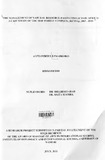| dc.description.abstract | This study examines the linkage between natural resource scarcity and conflicts in Kenya’s Mau Forest Complex (MFC), focusing on land and forests. Like other forests, the Mau offers immense ecosystem and socio-economic benefits to local communities and to the entire nation, its neighboring countries and beyond. Despite this importance, the last five decades have seen large portions of forest land converted into human settlements through clearing. The degradation of the forest resource coupled with the diminishing land availability has precipitated conflicts in this Kenya’s important forest ecosystem. The main aim of this study is to understand ways in which environmental scarcity leads to conflict. The study is framed along the hypotheses that forest and land based resource scarcities are the causes of conflicts in the Mau Forest Complex, and is informed by .the theoretical underpinnings founded on the eco-violence theory, advanced by T F Homer-Dixon. Based on the research question, the study employs survey research methodology which focused on the Mau Forest Complex as the case study. Primary data was obtained using structured questionnaires while secondary data was sourced from archival material. There have been concerns that the degradation of the MFC has affected the flow of benefits to the various economic sectors nationally and regionally, often resulting into conflicts amongst communities that are dependent on the ecosystem. This calls for the innovation of resource management interventions to mitigate the degradation and minimize competition for resources. This research has found that natural resources management in Kenya, like many other African countries have been influenced by the colonial legacy which stressed on “command and control” policies that have alienated local people from access to land and forest resources. This trend has persisted in the post-independence regimes, which have continued the colonial thrust of centralization in natural resources management, thereby resulting in skewed distribution of natural resources. The unequal distribution of natural resources is linked to the colonial legacy upon which current structural conflicts in the MFC are founded. Three types of resource scarcities have been shown to precipitate conflicts in the MFC; the supply induced scarcity which arises from the diminishing natural resource base, the demand induced scarcity arising from population increase and changes in consumption patterns of the population and finally, the structural scarcity that emanates from skewed distribution of resources, weak governance and inadequate policy and institutional set up in the management of natural resources. Structural scarcity of both land and forest resources has been identified as the most significant cause of conflicts in the MFC. The research proposes several mitigation measures to the management of conflicts that focus primarily on sustainable management of natural resources, as a conflict prevention measure. These include policy and institutional transformation, decentralization of natural resource management and applying modem science and technology innovations in natural resource management. This research recommends further examination of roles played by other conflict factors such as ethnicity and politics in the MFC in causing conflicts over natural resources. | en_US |



